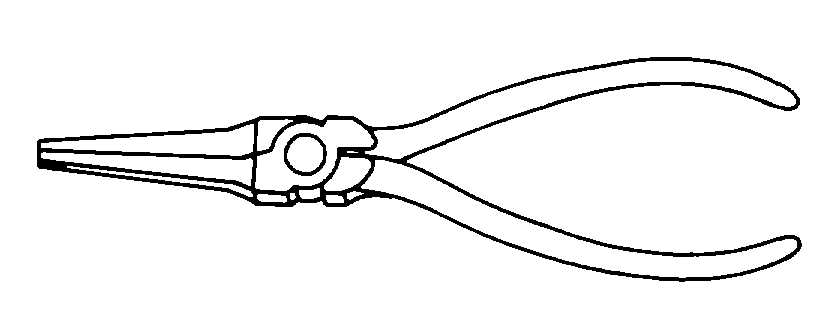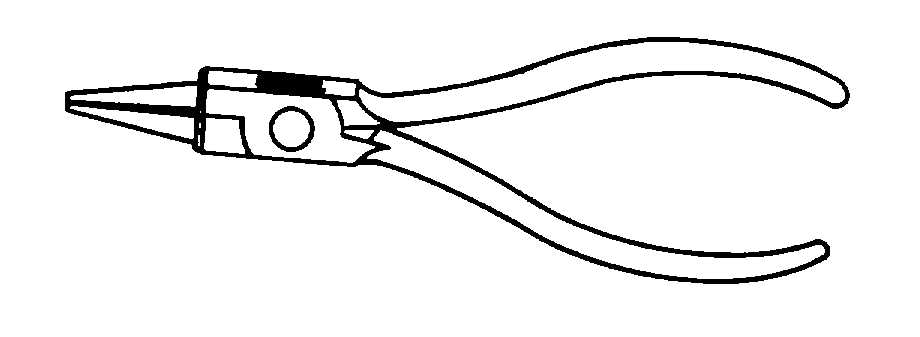TM 1-1500-204-23-9
Figure 4-44. Flat-Nose Pliers
(5)
Round-nose pliers. The round-nose pliers
are used to crimp flanges on sheet metal in the process
of shrinking, and for making loops in soft wire. It has
smooth, round jaws, a fixed pivot, and curved handles
which may have insulated sleeves. It is shown in figure
4-45.
(6)
Crimping pliers. Crimping pliers have
practically the same design as ordinary round-nose
pliers. Because a crimp in sheet metal is made by
twisting rather than clamping, they are constructed of
heavier material to withstand heavy side loads induced
by the twisting motion.
(7)
Water pump pliers. Water pump pliers,
sometimes referred to as channel lock pliers, are used
for their powerful grip and ability to adjust to several
different sizes. As figure 4-46 shows, there are two
adjustment methods used with this type of pliers.
(8)
Vise-grip pliers. Vise-grip pliers have a
clamping action which allows them to be clamped onto
an object. They will stay there and free the other hand
for other work. These pliers, shown in figure 4-47, are
sometimes made with a clamp-type jaw which allows
them to be used for clamping sheet metal. The vise-
grip pliers can be adjusted by turning the knurled
adjustment screw until the desired jaw dimension is
reached.
NOTE
Vise-grip pliers should be used with care
since the teeth in the jaws tend to
damage the object on which they are
clamped. Do not use them on nuts, bolts,
tube fittings, or other objects which must
be reused.
b.
Use. Pliers come in various sizes and should
be selected according to the job being performed. They
should never be used as a substitute for a wrench,
because this practice batters nut and jaw serrations
unnecessarily. Although there are several uses for
pliers, they are not an all-purpose tool and should not be
used as a pry bar or for hammering.
Figure 4-45. Round-Nose Pliers
c.
Repair. Generally speaking, repair of pliers is
limited to grinding or filing cutting or holding surfaces.
Further repair of pliers is usually impractical when
compared with the replacement cost.
(1)
Grinding. It is possible to grind or sharpen
some types of side cutting pliers. However, they should
be examined closely to see if they still close properly
after the material is ground away from the cutting edges.
Do not attempt to grind pliers not designed to be ground.
Grind
cutting
edges
so
that
ground
bevel
is
approximately at right angles to inside machined bevel.
Grind sparingly, and remove the same amount of stock
from both jaws. Cool often in water to preserve temper.
(2)
Renewing serrations. Jaw face serrations
may be renewed by placing pliers in a vise and renewing
serrations with a 4-or 5-inch, three-cornered file.
d.
Care. Observe the following practices for the
care and upkeep of pliers:
(1)
Remove dirt and grease with a clean rag
and apply a light coat of oil after each use.
(2)
Store pliers in a tool box or hang on racks
when not in use.
(3)
Do not remove insulation on handles or oil
handles which are insulated.
(4)
Do not use pliers for prying or for
removing nuts or bolts.
(5)
Replace all pliers which have broken
jaws, handles, or cutting edges.
4-6. Awls. Awls are used in aircraft maintenance to
align holes, as in the installation of a deicer boot, and to
place scribe marks on metal and plastic surfaces. A
typical awl is shown in figure 4-48.
4-15



